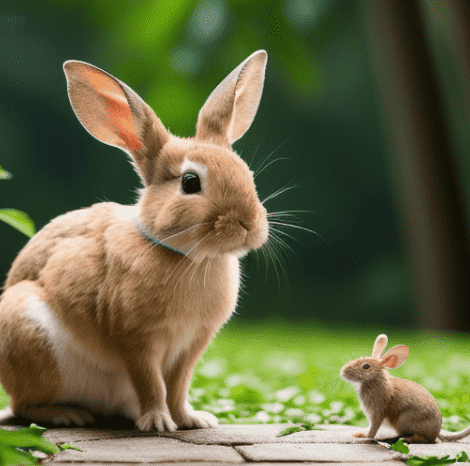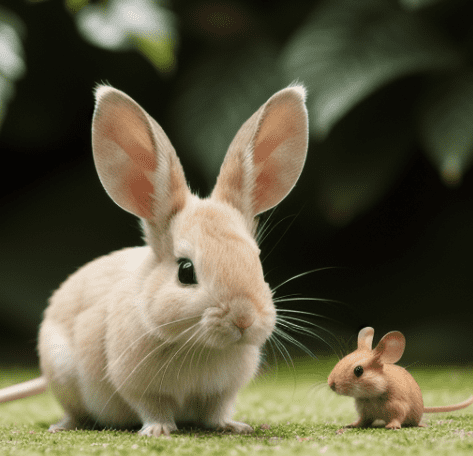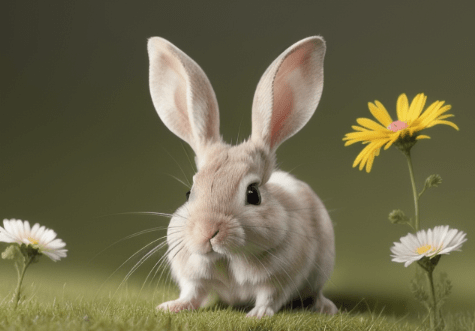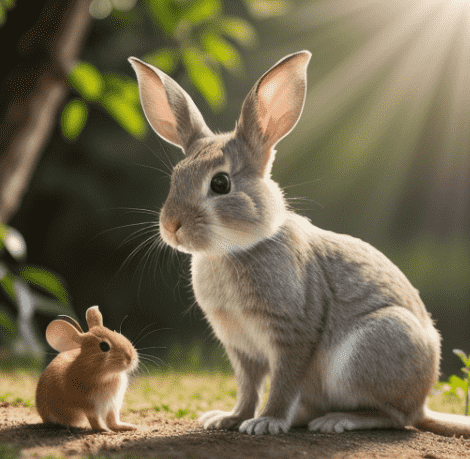Rabbit diets have been a topic of interest for many. One question that pops up often is, “Do rabbits eat mice?” Spoiler alert – they don’t!
The idea of them eating mice is an illusion, an absolute myth.
So, where does this misconception come from?
Scroll down and solve this mystery with us!
Table of Contents
Myth or Reality: Do Rabbits Eat Mice?

“Do rabbits eat mice?” is more myth than reality. Rabbits’ dietary habits provide insight into this misconception.
Rabbits don’t fall into the category of predators. They’re prey animals. Rabbits lack the necessary physical adaptations to hunt and consume meat. Their teeth, digestive systems, and behaviors are designed for a plant-based diet, not predatory.
The thought that rabbits are carnivorous and eat mice is baseless. It veers away from their natural feeding habits. Rabbits, let alone mice, have no biological or behavioral predisposition to consume meat.
Will Rabbits Kill Mice?
Rabbits and mice coexist more than conflict. So, why do rabbits kill mice? The answer is simple.
They prefer to hop around and munch their food rather than behave predatorily. Their instinct is more about self-preservation and less about hunting.
However, rabbits might kill mice when they need to protect their territory or are afraid. But it’s quite rare and not their usual behavior.
It’s worth noting that rabbits are more likely to be prey than predators in the wild. They are made for speed to escape danger, not to hunt.
Understanding Rabbit Diets
Rabbits are herbivores. This term refers to animals that eat only plant-based foods. It’s a diet where hay, fresh vegetables, fruits, and pellets are the main course. This fuel supports rabbit health and well-being.
Herbivores mean lots of fiber! You should give your rabbit high-quality hay in bulk, such as Timothy or Meadow Hay. This keeps their digestive systems running smoothly and wears down their teeth, preventing dental issues.
Rabbits also like pellets. They are essential to a rabbit’s diet, but you should feed them sparingly. Rabbit pellets typically contain hay, grains, seeds, vegetables, and other ingredients. They provide extra nutrients for rabbits. But you should never replace hay or fresh veggies.
As a rabbit ages, pellets should constitute a small part of its diet, while hay should always be available. If you are raising a younger rabbit, you should feed them Alfalfa pellets. But for older rabbits, Timothy pellets are preferred.
Fruits and vegetables are also a necessity for a balanced diet. Leafy greens, carrots, or small pieces of apples, watermelon, banana, or blueberries offer nutritious treats. But give them in moderation. Overfeeding can cause health issues.
Examining both Rabbit And Mouse Behavior as Prey Animals

Rabbits and mice share a common reality. They’re prey animals. This shared status shapes their interactions and behaviors in intriguing ways.
When we think of rabbits, images of gentle creatures nibbling on greens come to mind. Indeed, they are naturally peaceful, focusing on eating and socializing within their burrows.
But mice are small, fast, and non-aggressive. They’re more about foraging and staying out of sight. So, in the wild, there’s little conflict.
Rabbit-Mouse Interactions in the Wild
In the wild, rabbit burrows and mouse nests often overlap. Why? It’s safer in numbers. Their shared status as prey animals creates an odd community.
Rabbits, with their keen senses and robust burrows, protect mice. Mice, in turn, are quiet neighbors who don’t compete with rabbits for food.
So, they don’t necessarily coexist, but they coexist. But they eat one another? That’s a fiction story. Neither species threatens the other. They are companions for survival, each navigating the world of larger, fiercer animals in their unique ways.
Factors That Influence Rabbit-Mouse Interactions
Rabbits and mice interact in unique ways. These interactions often depend on environmental variables, food availability, and shelter conditions. As prey animals, both are cautious and prefer areas with safety and food access.
Can Mouse and Rabbit Live Together?
The living conditions of rabbits and mice are not ideal. Rabbits enjoy cleanliness and space, while mice explore and leave droppings. This difference can stress rabbits. Hence, it’s advisable to avoid keeping them together, especially in domestic settings.
Is Rabbits’ Hutch an Attraction for Mice?
A rabbit’s hutch can attract mice, but not from the rabbit itself. Hutches often provide shelter, warmth, and access to food, which appeal to mice. So, maintaining a clean hutch, removing leftover food, and ensuring no spaces for mice to enter can keep mice at bay. This approach contributes to the rabbit’s general health and comfort.
Common Mouse-Transmitted Diseases that Affect Rabbits

Mice can harm rabbits. They are potential carriers of several diseases that affect rabbit health. It’s essential for you to know these diseases. Let’s dive into these illnesses to understand their consequences.
Tularemia
Tularemia is caused by Francisella tularensis, often known as rabbit fever. This disease can linger in the environment for weeks, often carried by rodents such as mice. Rabbits can suffer severe illnesses, with symptoms ranging from fever to skin ulcers.
Hantavirus Pulmonary Syndrome
Hantavirus is a severe respiratory disease. Hantavirus is a severe respiratory disease. Researchers have found Hantavirus in infected mice’s droppings, urine, and saliva. Direct contact or inhalation can transmit it to rabbits, leading to respiratory distress, a symptom common in Hantavirus Pulmonary Syndrome.
Lymphocytic Choriomeningitis (LCM)
LCM, a viral infectious disease, originated from house mice. This infection in rabbits appears as a sudden loss of appetite, lethargy, and, in severe cases, neurological disorders.
Salmonellosis
Rodent feces contain Salmonella bacteria. Rabbits who eat it can get diarrhea, fever, and abdominal pain.
Leptospirosis
Infected mice carry Leptospirosis, a bacterial disease, in their urine. Rabbits exposed to this bacteria might suffer kidney damage, severe fatigue, and jaundice.
Rat-Bite Fever
Rat-Bite Fever can come from mice as well as rats. If an infected mouse bites your rabbit, it could contract this disease, leading to symptoms like fever, rash, and joint pain.
Listeriosis
The bacterium Listeria monocytogenes causes Listeriosis. Although this disease is more common in ruminants, rabbits can contract it from a mice-contaminated environment. Symptoms often include fever, balancing difficulty, and decreased social behavior.
Ectoparasites
Ectoparasites, such as mites and fleas, are often carried by mice. Once transferred to a rabbit, they can cause severe skin conditions, including inflammation, hair loss, and intense itching.
Toxoplasmosis
Toxoplasma gondii, a single-celled parasite, causes Toxoplasmosis. If a mouse infested with these ticks enters a rabbit’s habitat, it could expose the rabbit to this disease. This could lead to symptoms such as lameness, swollen joints, and loss of appetite.
Lyme Disease
Lyme disease, a condition caused by the bacterium Borrelia burgdorferi, is typically transmitted through ticks. If a mouse infested with these ticks enters a rabbit’s habitat, it could expose the rabbit to this disease. This could lead to symptoms such as lameness, swollen joints, and loss of appetite.
Preventive Measures to Minimize Mouse-Transmitted Diseases
Knowing about mouse diseases in rabbits is the first step. The next step is prevention. The primary rule is maintaining a clean and secure habitat for your rabbits. This discourages mice from entering and staying at home.
Avoid keeping food and water out in the open, which attracts rodents. Use containers that close securely for storing food. This not only prevents contamination but also helps keep mice away.
It’s also essential to use sealed and secure housing for your rabbit. This prevents mice from entering and interacting with your pet. Regularly inspect the hutch or cage for holes and gaps. Take prompt action if you spot mice’s signs, such as droppings or nibbling food.
Remember, prevention is key to protecting your rabbit from mouse-transmitted diseases. These simple yet effective steps can help keep your rabbit healthy and safe.
Conclusion
The idea that rabbits eat mice is a myth. Rabbits are herbivores, living strictly on plant-based diets. Mice, on the other hand, are unwelcome guests in rabbit territory. They pose risks by transmitting diseases, even if they don’t interact directly.
Prioritizing your rabbit’s health and safety is vital. Keep their habitat clean and secure. Preventing mouse intrusions is your first defense. Regular checks and prompt action at the first sign of mouse presence can save your rabbit from potential health risks.
Remember, knowledge is power. A well-informed pet owner can create a safe environment for their furry friends. That’s a reality, not a myth!
FAQs
Do rats hurt pet rabbits?
While rats are not typically aggressive toward rabbits, they can pose a risk due to their diseases. If a rat bites a rabbit, it could transmit a disease. So, it’s advisable to keep rats away from your pet rabbits for safety.
How do I keep mice away from my rabbit?
To keep mice away from your rabbit, ensure their environment is clean. Regularly clean the cabinet, remove leftover food, and ensure food is stored in mouse-proof containers. Also, block any small openings or gaps in the rabbit’s hutch to prevent mice from entering.
What rabbits cannot eat?
Rabbits cannot eat many foods. Some examples include chocolate, avocado, iceberg lettuce, potatoes, and rhubarb. These can be harmful to your rabbit’s health. Always research or consult a vet before introducing new foods to your rabbit’s diet.
Alina Hartley is a small-town girl with a ginormous love of bearded dragons. It all started with Winchester, a baby bearded who was abandoned at the shelter by his former owners because of a birth defect that caused one front leg to be shorter than the other. Alina originally went to the shelter looking for a guinea pig, but one look at Winchester and it was love at first sight. From that day on, Alina has dedicated her life to learning everything she can about bearded dragons. She loves helping new beardie parents start their incredible journey with these magnificent reptiles.
Follow her on:
LINKEDIN
TWITTER.
Read her latest articles HERE
Learn more about her HERE.


